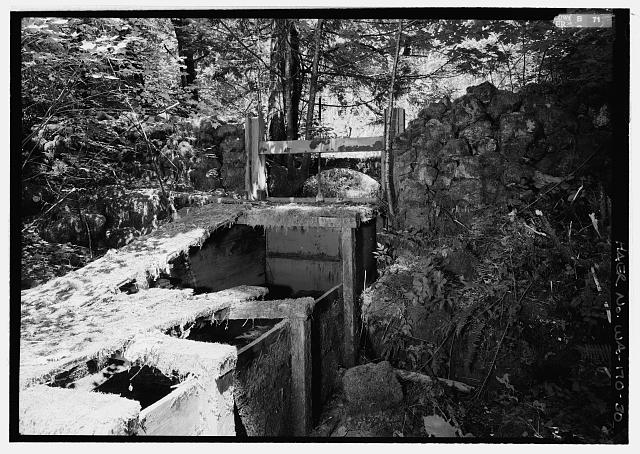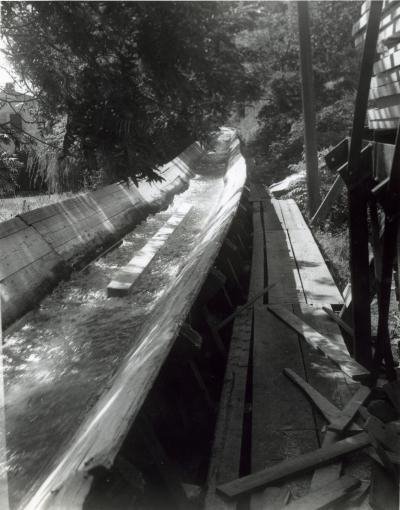
It Was the Last Working Flume in USA and it's Almost Gone
The Broughton lumber flume was a 9-mile wooden trough that transported rough-sawn timber (cants) from a lumber mill in Willard, WA to a finishing mill in Hood, WA. The first part of the flume was built in 1913 and ended at Drano Lake. A second flume was constructed between 1921 and 1923. This extended the flume length to the full 9 miles and ended at the Hood mill (near Underwood). When the flume ran across a private residence, it was initially leased. Broughton purchased the flume and right-of-ways in 1923. The flume water originated at the Little White Salmon River and flowed downhill at a rate of approximately 9 miles/hour. Since the flume was nine miles long, it took 55 minutes for a piece of lumber to make the trip from the Willard Mill to the Hood Mill. The flume transported about 130,000 to 150,000 board feet/day. This is enough to build about 12 homes. The flume was very stout. It had supports and legs every 4 feet. The flume was constructed out of 16-foot long 2 x 14" tongue & groove Douglas fir boards. The 2 x 14" boards were 2 inches thick which made the troughs tough and strong. Cedar lumber was used for the legs and supports because it was rot resistant. The flume was v-shaped on the bottom and the water ran about 2-feet deep. In a few places (road crossings), the flume was made of metal (3/8 inch steel plates welded together). The flume was a money saver for many years because it solved the problem of transporting the lumber down a 13-mile winding road by truck.
As you read thru this article, you will see pictures of the flume in different stages of its life. At the end of this blog, you will see time lapse photos showing the deterioration of the flume.

The flume
descended a total elevation of about 1000 feet over its nine-mile course and at some points was over 80 feet off of the ground. Over the last 4 miles, the flume was built along the
cliff side of the Columbia River. The flume was an attraction for both people and animals. It was not uncommon for the flume crew to find porcupines, deer and rattlesnakes along the trough.
Flume Facts
Designer/Engineering/Fabrication: Drano Flume and Lumber Co. (upper part) and Broughton Lumber Co. (lower part)
Date of Construction: 1913 and 1921-1923
Approximate Cost: $10,000/mile
Total Flume Length: 9 miles
Flume lumber speed: 9 miles/hour
Transit Time from Willard to Hood: 55 minutes
All lumber for flume construction came from Willard mill
Type of Material used: Douglas Fir, Cedar and some Tamarack
Willard Elevation: 1200 feet above sea level
Hood Elevation: 200 feet above sea level
Total Elevational Drop of Flume: 1000 feet
High Point of Flume Trestle: 82 feet off of ground
Number of Overhead Road Crossings: 2 (Cook Underwood Rd and Young's Rd)
Number of Crossings Under Roads: 4 (Willard Rd 2x, Oklahoma and Chenoweth Rd)
The flume crossed the Little White Salmon River once
The feeder flume crossed Lava Creek once
The Broughton Lumber Company

The flume system worked so well that the upper mill (Willard) would start work at 7am and the lower mill (Hood) would start work at 8am so the lumber would be there waiting for them.

Hood, WashingtonThe town of Hood (est population 20) is the current location of the
Broughton Lumber Co. It is located just west of Underwood. It currently has about 8 homes and the empty lumber company. The lumber co. has the feel of a "ghost town". It is currently being evaluated for a wind surfing resort.

The flume could handle cant
lengths of up to 40 feet. Anything longer was usually trucked down to the lower mill. A dam built by the Pacific Power and Light Co. on The Little White Salmon River above Willard, WA provided the head (water propulsion) for the flume.
.
Flume Maintenance and Repair
A 12-inch walkway ran parallel the entire length of the flume for repairs and maintenance. The flume was patrolled and maintained by a 5-man crew. This crew was responsible for repairing and doing periodic checks on the flume. The daily pounding of the cants on the flume, freezing weather, leaks, lumber jams, plus the extensive length of the flume probably kept this crew busy. Rolling rocks from higher up on the mountainside posed the biggest threat to the flume. The repairman could use the flume to float materials to the repair site.
The flume was being rebuilt constantly. New sections replaced older sections as to keep the flume in a constant state of flux. A section of flume had a service life of about 15 to 20 years after which time it needed to be replaced. The high trestle section was replaced in 1969.
The flume also had a 6-volt warning system running up the flume from Hood to about the half way point at Chenoweth Rd. Thin trip wires ran along side the flume and if either wire was broken, it would signal the dump shack to pull out a section of the flume and divert the water into Drano Lake. An alarm sounded in 2 different offices at the Hood mill (the Mill Superintendent and the Flume Boss). When these alarms sounded, people went into action FAST! It was thought that the water and lumber released by a break could potentially cause a landslide and wipe out the railroad and highway below.

The flume has much historical significance. The engineering is impressive. The cost-effectiveness at the time of operation is equally impressive. It was also the last functioning lumber flume of it's type in the United States and the longest working flume in the world when it closed down on Dec 19, 1986.
 The flume was not designed to be water tight and some leakage was normal.
The flume was not designed to be water tight and some leakage was normal.
During times of winter freezing, the flume could have icicles running from the trough to the ground, sometimes of up to 20 feet high. The flume was shut down during severe freezes.

Like much of the lumber industry itself, the flume was ephemeral in nature.

A plaque at Drano Lake on Hwy 14 provides info and pictures about the flume.

End of the Flume
In December of 1986, the flume and the Willard mill were both closed. This happened because the supply of large diameter logs were disappearing. The new age forests couldn't supply the Willard mill with enough timber to make it economical. Other reasons may have included the environmental impact on the Columbia and Little White Salmon River, upkeep on the aging flume and insurance liability reasons. After the flume was shut down, it was dismantled in several critical areas. Some of the flume segments were taken for souvenirs, some pieces were put in museums and parks while the rest was allowed stand and bare the elements (slowly bending to the will of gravity). In May of 2009, I visited the flume and found it to be mostly in ruins. I estimate that in less than 20 years, the flume will be gone, with the exception of the 2 metal structures. If you want to see the flume, do it soon. The longer you wait, the less of it you will see.
 The Town of Willard
The Town of Willard
Former lumber town. Population 46. The town at one time had the Broughton Lumber Mill, a gas station, 17 company houses and a company store. It was the oldest mill in Skamania County when it closed in 1986. Some of the nicest people you will meet anywhere.
.
Retracing the Flume's Path
The Broughton flume and it's water originated from a dam at the Little Salmon River just north of Willard. Water was gravity fed from the dam into the feeder flume which crossed Lava Creek, ran along Oklahoma St. and then went under Oklahoma St., resurfaced and ran along Flume Rd. towards the Willard mill where it picked up lumber.
From the mill, it crossed under Willard Rd. (Co Hwy 86), went over the Little Salmon River and under Willard Rd. From here, it paralleled a service road (name unknown) where it crossed John Young's Road. The crossing structure was initially made of wood and later was made of metal. After this, it headed south and paralleled Willard Rd. From here, the flume took a SW direction and headed for Chenoweth Rd. It crossed Cook-Underwood Rd with the large green steel span just north of Chenoweth Rd (mile post 8). Next, it paralleled Chenoweth Rd and crossed under this road just before the road ends. This is also the location of the emergency water dump portion of the flume. In addition, this is the half way point of the flume: 4 and 1/2 miles each way to both Willard and Hood. From here, the flume wrapped around the hillside and began it's descent towards the Hood mill. It parallels Hwy 14 and is visible along the cliff above the highway. It can also be seen from across the river on the Oregon side. A good place to see this is Mitchell Point.
.
Restoration and Preservation of the Flume
An organized attempt should be made to preserve some parts of the flume. The 2 metal structures that once crossed the roads are in good shape and will last a long time. The one in Bingen has been repainted recently. The area of Chenoweth seems like a good place for a historical site to preserve part of the flume. It has good access and much of the flume still remains there. A trestle portion of the flume would be a nice tribute, but access and cost may be a problem.
 Broughton Flume Time Line
Broughton Flume Time Line 1913 Flume built from Willard to Drano Lake
1916 Harold J Broughton and DM Stevenson operate mill at Willard
1920 Broughton Lumber Company opens
1923 Broughton Lumber Co. buys flume
1923 Broughton Lumber Co. constructs additional 4 1/2 miles of flume to Hood mill
1946 Post war lumber boom
1947 Flume damaged by rock slide caused by goats
1963 Ice storm damages flume in several places
1969 National Environmental Protection Laws enacted
1969 Fire destroys 1/4 mile of the flume
1972 EPA/US Forest Service restricts clear-cutting of forests
1975 Broughton Lumber Co. peaks with 450 employees
1980 Lumber mills retool for smaller logs
1986 Willard Lumber Mill closes and flume shuts down
1987 Some sections of flume auctioned off and dismantled
1987 Green metal overpass moved from highway to Willard
1987 Willard mill razed
1987 High trestle portion of flume dynamited
2007 44 turbine unit wind power project proposed
2007 245 unit destination resort project proposed at Broughton
.
References:
The Oregonian, Dec 19, 1986
The Oregonian, Jul 28, 1972
The Oregonian, Aug 10, 1969
Historic American Engineering Record, HAER WA-170, Richard O'Connor 2000, National Park Service, Washington DC
The Kingman Daily Miner (Arizona Newspaper), Nov 15, 1978
Society for Industrial Archeology,Winter 1986, Vol 15 Number 4, National Museum American History, Smithsonian Institution, Wash DC
.
The Gorge Heritage Museum, Bingen WA
.
The Broughton Lumber Co. Flume and Railroad, Ely and Pomeroy, Narrow Gauge and Shortline Gazette, vol 14, #5, Nov/Dec 1988
.
Logging: The Principles and General Methods of Operation in the US, Bryant, 1913 pages 408-413
.
Google Earth
Special Thanks to:
Cam Thomas
Gary (Willard)
Gene (Willard)
Taylor (Willard)
Doug (Broughton Mill)
.
During the process of researching the flume, I came across discrepancies in information. I welcome your help in making the information here more accurate.
.
If you have any questions, comments or information about the flume, please contact me at:
rumblefish351@aim.com.
Thanks for stopping by!
















































